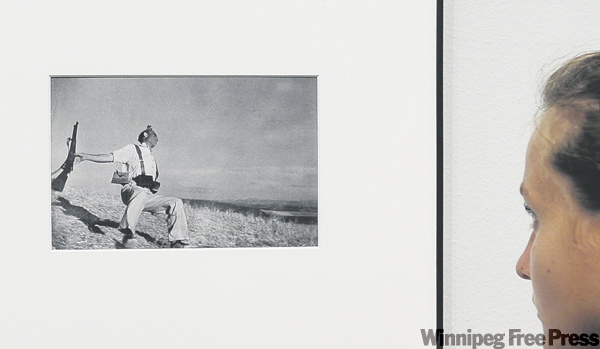Iconic Spanish Civil War photograph a fake?
Robert Capa's Falling Militiaman may have been staged: researchers
Advertisement
Read this article for free:
or
Already have an account? Log in here »
To continue reading, please subscribe:
Monthly Digital Subscription
$0 for the first 4 weeks*
- Enjoy unlimited reading on winnipegfreepress.com
- Read the E-Edition, our digital replica newspaper
- Access News Break, our award-winning app
- Play interactive puzzles
*No charge for 4 weeks then price increases to the regular rate of $19.00 plus GST every four weeks. Offer available to new and qualified returning subscribers only. Cancel any time.
Monthly Digital Subscription
$4.75/week*
- Enjoy unlimited reading on winnipegfreepress.com
- Read the E-Edition, our digital replica newspaper
- Access News Break, our award-winning app
- Play interactive puzzles
*Billed as $19 plus GST every four weeks. Cancel any time.
To continue reading, please subscribe:
Add Free Press access to your Brandon Sun subscription for only an additional
$1 for the first 4 weeks*
*Your next subscription payment will increase by $1.00 and you will be charged $16.99 plus GST for four weeks. After four weeks, your payment will increase to $23.99 plus GST every four weeks.
Read unlimited articles for free today:
or
Already have an account? Log in here »
Hey there, time traveller!
This article was published 24/07/2009 (5977 days ago), so information in it may no longer be current.
MADRID — Robert Capa’s photograph of a falling Spanish Civil War militiaman became one of the most famous and enduring images of conflict in the 20th century. Now, Spanish researchers believe it may have been staged.
When published in September 1936 by French magazine Vu, and later in Life magazine, the caption on the legendary photojournalist’s Falling Militiaman said it depicted the moment a Republican rifleman was mortally wounded.
The location was given as Cerro Muriano on the Cordoba front, where forces backing Gen. Francisco Franco were engaged in fighting with soldiers loyal to the elected Republican government.

Now Spanish researchers say that not only was the photograph not taken where Capa said it was, but that the militiaman was most likely not shot either. After studying the photograph and new images released as part of a travelling exhibition called This is War now at Barcelona’s art museum, four researchers say the photographs were shot 55 kilometres away in an area where there was no fighting the day they were taken.
"It quickly became obvious to us that among the new photographs — 34 attributed to Capa, 6 to his companion Gerda Taro — there were four that revealed the exact place where Capa had taken the shots," filmmaker Raul Riebenbauer told The Associated Press.
Historian Francisco Moreno has taken geographical information in the photographs — the shape of seven hills, the location of two farmhouses and several roads — and found it matched exactly a hillside just east of the town of Espejo.
For Spaniards, Falling Militiaman is a searing reminder of a 1936-39 internal conflict that deeply divided a nation along political lines and cost at least 500,000 lives. For Capa it was the image that catapulted his career as the world’s foremost war photographer.
The International Center of Photography, founded by Capa’s brother, Cornell and custodian of his legacy, has spent 25 years trying to ascertain the veracity of the image, director Buzz Hartshorn told The AP: "Capa was partisan, he believed in the anti-fascist cause and he saw Spain as one of the last places where you could make a stand."
He said the truth behind the picture was almost certainly "unknowable."
Riebenbauer said he and colleagues worked extensively with forensic doctors and found puzzling aspects to the photograph that they aired in a film called The Shadow of the Iceberg.
Among other issues, they find it troubling there is no evidence of a bullet wound in the photograph. That Vu should have published a separate Capa photograph of another militiaman shot dead at the same hillside spot has also always raised eyebrows. Even Capa’s biographer Richard Whelan had doubts about Falling Militiaman. "I have wrestled with the dilemma of how to deal with a photograph that one believes to be genuine but that one cannot know with absolute certainty to be a truthful documentation," Whelan wrote in his book, This Is War! Robert Capa at work.
To David Valsells, curator of the Barcelona show, the image reveals the full historical context of war photography at the time. Taro was killed in Spain by a tank while Capa died when he stepped on a land mine in Vietnam, camera in hand.
— The Associated Press

